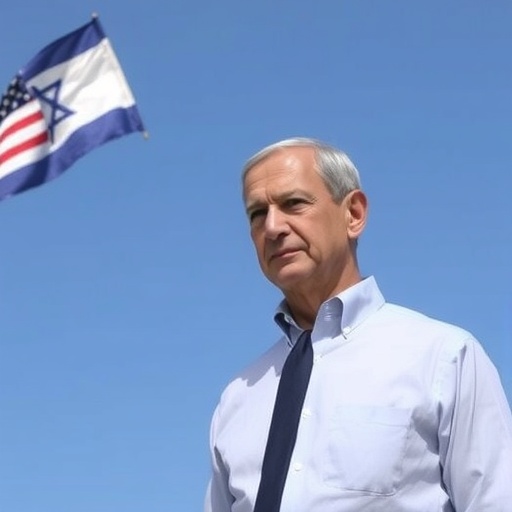Top U.S. Officials Rush to Israel as Netanyahu Issues Dire Gaza Ceasefire Warning
In a move that underscores the fragility of Middle East peace efforts, senior U.S. officials have arrived in Israel for emergency talks, just hours after Prime Minister Benjamin Netanyahu issued a stark warning that the ongoing Gaza ceasefire could collapse at any moment. This development, reported on Wednesday, heightens fears of renewed violence in the region and prompts questions about the sustainability of U.S.-brokered diplomatic initiatives amid escalating tensions.
The ceasefire, which has held tenuously since late last month following intense negotiations, was meant to provide a breathing space for humanitarian aid delivery and civilian evacuations in Gaza. However, Netanyahu’s comments during a press conference in Jerusalem suggested that provocations from Hamas and other militant groups could unravel the agreement swiftly. “We cannot stand idly by while terrorists exploit this pause,” Netanyahu declared, emphasizing Israel‘s commitment to its security. The arrival of the U.S. delegation, led by high-ranking State Department envoys, signals Washington’s deep concern over the potential breakdown and its broader implications for regional stability.
Netanyahu’s Fiery Rhetoric Ignites Ceasefire Fears
Prime Minister Netanyahu’s threat came amid reports of sporadic rocket fire from Gaza into southern Israel, incidents that Israeli officials attribute to Hamas violations of the ceasefire terms. Speaking to a packed room of journalists, Netanyahu painted a grim picture: “The ceasefire is on life support. If Hamas continues its provocations, we will respond with the full force necessary to protect our people.” His words echoed longstanding Israeli grievances, including the group’s refusal to fully disarm and the ongoing hostage crisis involving over 100 individuals still held in Gaza.
Historically, ceasefires in the Israel-Gaza conflict have been short-lived. Data from the United Nations indicates that since 2008, there have been at least 12 major escalations, each lasting from days to months, resulting in over 5,000 Palestinian deaths and hundreds on the Israeli side. The current truce, facilitated by U.S., Egyptian, and Qatari mediators, was hailed as a breakthrough after weeks of airstrikes and ground operations that displaced nearly 2 million Gazans. Yet, Netanyahu’s administration has faced domestic pressure from hardline coalition partners who view any pause in military action as a concession to terrorism.
Critics within Israel argue that Netanyahu’s rhetoric serves political ends, bolstering his image ahead of potential elections. “This is posturing,” said opposition leader Yair Lapid in a televised interview. “But it risks dragging us back into the abyss.” International observers, including EU diplomats, have urged restraint, warning that a collapse could lead to a humanitarian catastrophe in Gaza, where aid convoys have only recently begun delivering essentials like food and medical supplies to besieged areas.
U.S. Officials’ Urgent Jerusalem Summit with Israeli Leaders
The U.S. officials’ visit to Israel represents a frantic diplomatic push to salvage the ceasefire. Leading the delegation is Under Secretary of State for Political Affairs Victoria Nuland, accompanied by National Security Council representatives and Middle East experts. Their itinerary includes closed-door meetings with Netanyahu, Defense Minister Yoav Gallant, and Foreign Minister Gideon Sa’ar, focusing on de-escalation strategies and intelligence sharing.
White House sources describe the trip as “critical to preventing a full-scale resumption of hostilities.” In a statement released en route, Secretary of State Antony Blinken emphasized, “The United States remains steadfast in our alliance with Israel while pushing for a sustainable path to peace in Gaza. We are here to listen, mediate, and act.” This marks the third high-level U.S. intervention in the crisis this year, following Blinken’s own visits to the region in January and May.
Discussions are expected to cover thorny issues like the release of Palestinian prisoners in exchange for Israeli hostages, the expansion of humanitarian corridors into Gaza, and guarantees against arms smuggling through Egyptian borders. U.S. officials have reportedly brought fresh intelligence on Hamas leadership movements, aiming to assure Israel that Washington is committed to neutralizing threats without derailing the truce. However, tensions simmer: Israeli media reports suggest Netanyahu is demanding stricter enforcement mechanisms, including U.S.-monitored no-fly zones over Gaza.
The delegation’s presence also highlights the Biden administration’s balancing act. Domestically, progressive Democrats have criticized U.S. support for Israel, while Republican hawks push for more aggressive stances against Iran-backed groups in Gaza. Polls from Pew Research show American public opinion split, with 48% favoring diplomatic solutions over military aid—a shift that could influence the talks’ outcomes.
Ground Zero: Gaza’s Fragile Truce Under Siege
On the ground in Gaza, the ceasefire’s benefits are already waning. Residents in Khan Younis and Rafah describe a tense atmosphere, with Israeli checkpoints tightening and Hamas patrols increasing. According to the Gaza Health Ministry, over 1,200 people have been killed since the October 7 attacks that sparked the latest conflict, with infrastructure damage estimated at $10 billion by World Bank assessments.
Humanitarian organizations like Doctors Without Borders report that while aid has trickled in—delivering 500 tons of flour and medicine this week—distribution remains hampered by security fears. “The ceasefire is a thin veil over chaos,” said one aid worker anonymously. “Families are terrified that one rocket could end it all.” Israeli forces, meanwhile, maintain a presence along the border, conducting what they call “defensive drills” that locals interpret as intimidation.
From Hamas’s perspective, the truce is a tactical respite. Spokesman Sami Abu Zuhri stated in a Beirut interview, “Israel’s aggression won’t cease without justice for Palestinians. We stand ready to defend our people.” This defiance has fueled Netanyahu’s warnings, creating a cycle of accusation and counter-accusation. Regional allies like Qatar, which hosts Hamas political leaders, are mediating via backchannels, but progress is slow.
Statistics underscore the stakes: The International Committee of the Red Cross notes that 80% of Gaza’s 2.3 million population relies on aid, with unemployment at 50% pre-conflict. A collapse could displace another 500,000, per UN estimates, overwhelming neighboring Jordan and Egypt.
Regional Ripples and Global Diplomatic Pressure
The potential Gaza ceasefire collapse reverberates beyond Israel and Gaza, straining alliances across the Middle East. Iran, accused by Israel of funding Hamas, has ramped up proxy activities in Lebanon and Yemen, prompting U.S. naval deployments to the Red Sea. Saudi Arabia, in normalization talks with Israel, has paused progress, citing the humanitarian toll in Gaza.
European leaders, including UK Prime Minister Rishi Sunak, have called for an emergency UN Security Council session. “A breakdown here could ignite the entire region,” Sunak tweeted. In the U.S., Congress is debating a $14 billion aid package for Israel, with amendments tying funds to ceasefire adherence—a move Netanyahu’s team lobbies against fiercely.
Expert analysis from the Brookings Institution suggests that U.S. involvement is pivotal. “Washington’s leverage lies in its military aid and veto power at the UN,” said analyst Tamara Cofman Wittes. “But Netanyahu’s domestic politics make concessions hard.” Quotes from think tanks highlight the irony: While the U.S. pushes for two-state solutions, settlement expansions in the West Bank continue, complicating Gaza talks.
Protests in U.S. cities like New York and Los Angeles draw thousands, demanding an end to arms sales to Israel. Social media amplifies voices from Gaza, with #SaveTheCeasefire trending globally, pressuring officials to act.
Charting the Path Forward: U.S. Strategy and Ceasefire Prospects
As U.S. officials huddle in Jerusalem, the focus shifts to actionable next steps. Proposals under discussion include extending the ceasefire by 60 days, tied to phased hostage releases and international monitoring. Netanyahu has hinted at openness to “phased escalations” if Hamas complies, while U.S. envoys push for economic incentives, like reopening Gaza’s port under joint supervision.
Long-term, the Biden administration eyes a broader framework involving Palestinian Authority reforms and Arab state recognitions of Israel. Yet, challenges abound: Internal Israeli divisions, Hamas intransigence, and U.S. election-year politics could derail efforts. Intelligence reports warn of Iranian shipments to Gaza militants, potentially tipping the balance.
Optimists point to past successes, like the 2014 truce that held for two years. Pessimists, however, foresee a “low-boil conflict” persisting. As one U.S. official confided to reporters, “We’re walking a tightrope, but collapse isn’t inevitable if all sides commit.” The coming days will test this resolve, with the world watching whether diplomacy can avert another Gaza crisis. Implications for U.S. foreign policy loom large: Success could bolster Biden’s legacy; failure might embolden adversaries and fracture alliances.
In the interim, families on both sides cling to hope. In Tel Aviv, a vigil for hostages draws crowds chanting for peace. In Gaza City, children play amid rubble, unaware of the diplomatic storm brewing. The path forward demands unprecedented cooperation, lest the ceasefire’s collapse usher in darker days for Israel, Gaza, and beyond.









